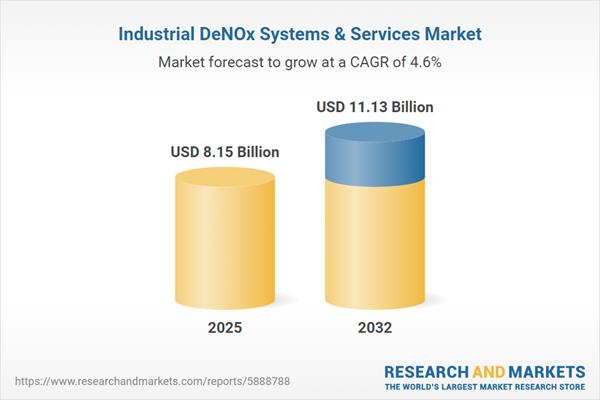Speak directly to the analyst to clarify any post sales queries you may have.
Industrial DeNOx Systems & Services are increasingly central to industrial strategy, enabling senior leaders to address stricter environmental compliance obligations while supporting resilient business operations. These systems equip organizations to better manage regulatory complexity and operational risk.
Market Snapshot: Industrial DeNOx Systems & Services Market
The global Industrial DeNOx Systems & Services Market is forecast to grow from USD 7.79 billion in 2024 to USD 8.15 billion by 2025. This projected growth signals steadily rising investment in advanced emissions management platforms as regulations continue to evolve globally. Today’s shifting regulatory landscapes compel organizations to update environmental strategies, moving toward digital management solutions and analytics-powered systems that enable real-time emissions monitoring and data-driven decisions. Enhanced connectivity and operational agility are proving essential, allowing companies to quickly address new compliance challenges and policy directives. These trends underscore the sector’s strategic role in supporting compliance and business resilience for heavy industry operators.
Scope & Segmentation of the Industrial DeNOx Systems & Services Market
This report delineates the critical market segments where emissions control creates value for senior leaders, directly impacting investment strategies, risk oversight, and lifecycle management. Each segment reflects unique operational demands and regional conditions.
- Technology: Core solutions, including Selective Catalytic Reduction (SCR) and Selective Non-Catalytic Reduction (SNCR), integrate with numerous plant architectures. Their modular designs ensure adaptability to various process needs and evolving regulations, making them highly suitable for plants that require tailored deployment options or plan for future system upgrades.
- End-Use Industry: Industries such as cement, oil and gas, power generation, steel, and chemicals each face distinct emissions requirements and compliance environments. Segment-focused technical strategies ensure that DeNOx solutions meet sector-specific production and regulatory demands efficiently.
- Service Type: Industrial service offerings span new system installation, retrofitting of existing infrastructure, upgrades, catalyst regeneration, and continuous emissions monitoring. Customized support, including scheduled and predictive maintenance, empowers operators to respond proactively to operational change and compliance expectations.
- Fuel Type: Solutions encompass coal, oil, and gas-fired assets, with flexible engineering approaches tailored for both local and international environmental mandates. This diversity supports effective compliance across asset portfolios with varying energy sources.
- Geographic Coverage: North America, Latin America, Europe, Asia-Pacific, the Middle East, and Africa present diverse plant infrastructure and regulatory contexts. Regional differences in innovation, technology adoption, and preferred support models underscore the importance of locally nuanced approaches to system implementation and service.
- Company Landscape: Leading providers—including John Zink Hamworthy Combustion LLC, Babcock & Wilcox Enterprises, Siemens Energy, Mitsubishi Heavy Industries, Johnson Matthey, Haldor Topsoe, Clariant, Wood, Ducon Technologies, and Hitachi Zosen—deliver solutions that balance global expertise with sensitivity to regional operational requirements.
Key Takeaways for Decision-Makers
- Advanced DeNOx systems enhance organizational resilience, supporting leaders facing increasingly varied and stringent global compliance frameworks.
- Integrating digital twin technology and AI analytics improves predictive maintenance, elevating operational responsiveness and resource efficiency for industrial operators.
- Strategic selection between SCR and SNCR technologies allows organizations to align emissions systems with specific process requirements, ensuring minimal disruption and optimizing facility performance.
- Comprehensive lifecycle support—covering installation, retrofitting, and constant technical assistance—preserves the value of capital investments and sustains compliance over time.
- Staying abreast of shifting regulatory and policy trends enables timely, informed resource allocation and capital planning, fostering sustainable compliance practices.
Tariff Impact
Recent tariffs in the United States affecting key catalyst materials, components, and chemicals are contributing to growing procurement complexity within the Industrial DeNOx Systems & Services Market. In response, companies are diversifying supplier relationships and adopting robust risk management practices to ensure continuous operations despite evolving trade challenges.
Methodology & Data Sources
This analysis synthesizes findings from expert interviews with sector leaders and policymakers, as well as a review of respected technical publications and comprehensive industry reports. This multifaceted approach ensures insights are rooted in real-world operational and regulatory contexts.
Why This Report Matters
- Provides actionable analysis of regulatory, technical, and investment priorities, enabling executives to adjust compliance strategies in line with changing market conditions.
- Highlights key emissions standards and service innovations to help organizations align their operations with emerging regulatory and technical mandates.
- Equips companies with guidance for strengthening resilience and managing supply-side risks by leveraging best available technologies and adapting to regulatory timelines.
Conclusion
Industrial DeNOx Systems & Services empower businesses to anticipate and manage evolving compliance challenges, fostering reliable operations and robust resiliency amid shifting market and regulatory dynamics.
Additional Product Information:
- Purchase of this report includes 1 year online access with quarterly updates.
- This report can be updated on request. Please contact our Customer Experience team using the Ask a Question widget on our website.
Table of Contents
3. Executive Summary
4. Market Overview
7. Cumulative Impact of Artificial Intelligence 2025
Companies Mentioned
The companies profiled in this Industrial DeNOx Systems & Services market report include:- John Zink Hamworthy Combustion LLC
- Babcock & Wilcox Enterprises, Inc.
- Siemens Energy AG
- Mitsubishi Heavy Industries, Ltd.
- Johnson Matthey plc
- Haldor Topsoe A/S
- Clariant AG
- Wood plc
- Ducon Technologies, Inc.
- Hitachi Zosen Corporation
Table Information
| Report Attribute | Details |
|---|---|
| No. of Pages | 187 |
| Published | October 2025 |
| Forecast Period | 2025 - 2032 |
| Estimated Market Value ( USD | $ 8.15 Billion |
| Forecasted Market Value ( USD | $ 11.13 Billion |
| Compound Annual Growth Rate | 4.5% |
| Regions Covered | Global |
| No. of Companies Mentioned | 11 |









